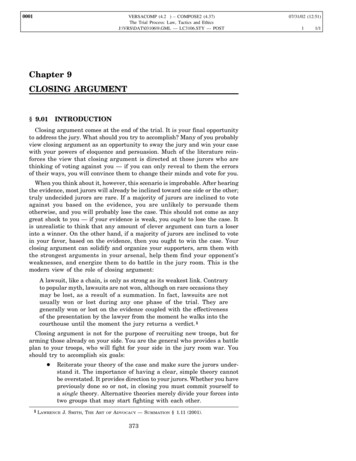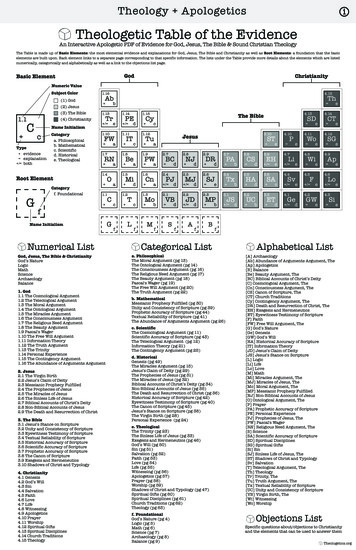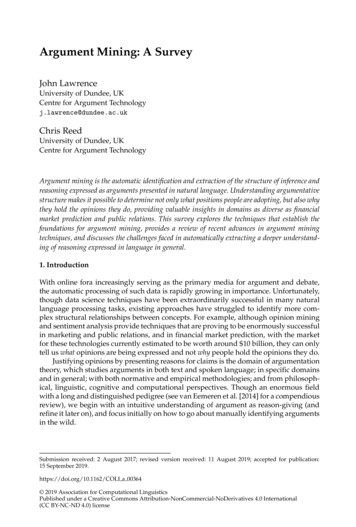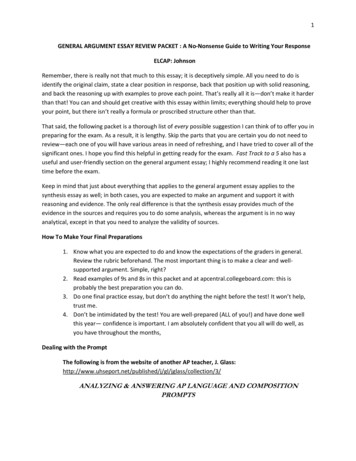
Transcription
0001VERSACOMP (4.2 ) – COMPOSE2 (4.37)The Trial Process: Law, Tactics and EthicsJ:\VRS\DAT\03106\9.GML --- LC3106.STY --- POSTChapter 9CLOSING ARGUMENT§ 9.01INTRODUCTIONClosing argument comes at the end of the trial. It is your final opportunityto address the jury. What should you try to accomplish? Many of you probablyview closing argument as an opportunity to sway the jury and win your casewith your powers of eloquence and persuasion. Much of the literature reinforces the view that closing argument is directed at those jurors who arethinking of voting against you — if you can only reveal to them the errorsof their ways, you will convince them to change their minds and vote for you.When you think about it, however, this scenario is improbable. After hearingthe evidence, most jurors will already be inclined toward one side or the other;truly undecided jurors are rare. If a majority of jurors are inclined to voteagainst you based on the evidence, you are unlikely to persuade themotherwise, and you will probably lose the case. This should not come as anygreat shock to you — if your evidence is weak, you ought to lose the case. Itis unrealistic to think that any amount of clever argument can turn a loserinto a winner. On the other hand, if a majority of jurors are inclined to votein your favor, based on the evidence, then you ought to win the case. Yourclosing argument can solidify and organize your supporters, arm them withthe strongest arguments in your arsenal, help them find your opponent’sweaknesses, and energize them to do battle in the jury room. This is themodern view of the role of closing argument:A lawsuit, like a chain, is only as strong as its weakest link. Contraryto popular myth, lawsuits are not won, although on rare occasions theymay be lost, as a result of a summation. In fact, lawsuits are notusually won or lost during any one phase of the trial. They aregenerally won or lost on the evidence coupled with the effectivenessof the presentation by the lawyer from the moment he walks into thecourthouse until the moment the jury returns a verdict. 1Closing argument is not for the purpose of recruiting new troops, but forarming those already on your side. You are the general who provides a battleplan to your troops, who will fight for your side in the jury room war. Youshould try to accomplish six goals: 1Reiterate your theory of the case and make sure the jurors understand it. The importance of having a clear, simple theory cannotbe overstated. It provides direction to your jurors. Whether you havepreviously done so or not, in closing you must commit yourself toa single theory. Alternative theories merely divide your forces intotwo groups that may start fighting with each other.LAWRENCE J. SMITH, THE ARTOFADVOCACY — SUMMATION § 1.11 (2001).37307/31/02 (12:51)11/1
0002VERSACOMP (4.2 ) – COMPOSE2 (4.37)The Trial Process: Law, Tactics and EthicsJ:\VRS\DAT\03106\9.GML --- LC3106.STY --- POST374CLOSING ARGUMENTCH. 9 Emphasize favorable evidence, but don’t waste time with a detailedrehashing of every detail as if the jurors were too stupid to remember anything. Rebut your opponent’s allegations. Suggest specific ways for the jury to resolve conflicts in your favor— both affirmative reasons why your position is right, and negativereasons why your opponent’s position is wrong. Explain the law and show how the evidence satisfies all legalrequirements for a verdict in your favor. Most importantly, reduce your case to a good story, including plot,motives, adventure, battles between good and evil, human weaknesses, temptation, drama, and a moral at the end.NOTECan you change a juror’s mind? Social scientists who study persuasion andhuman behavior think not. An argument against a juror’s tentative decisionmay only strengthen that juror’s belief as he or she thinks up counterarguments. The more you try, the more jurors may feel they are being manipulated or pressured to change their views, the more they will tend to react tothis threat by rejecting the message. See RICHARD E. PETTY & JOHN T.CACIOPPO, COMMUNICATION AND PERSUASION 126–30 (1986); SHARON S.BREHM & JACK W. BREHM, PSYCHOLOGICAL REACTANCE: A THEORY OF FREEDOM AND CONTROL (1981) (detailed explanation of reactance theory). Anyonewho has ever tried to persuade a four-year-old child to change his or her mindwill understand the problem.§ 9.02EXAMPLE OF A CLOSING ARGUMENTThe following example should give you a feeling for the scope and structureof a closing argument. It illustrates most of the points raised in later sections. 2May it please the court; members of the jury.I have asked my client to leave the courtroom, as I had asked himnot to be here during the medical testimony. We listened to the doctorsexplaining what a dismal future he has. He is going to be in a wheelchair, unable to walk more than a few steps because of his paralysis,a boy with no arms, only grotesque mechanical claws, for the rest ofhis life. That is a fact, and we have to accept it and base our decisionson it. Ben is only fourteen years old, and still has the hope — thedream of doctors inventing bionic arms that look natural, the dreamof being able to run again. I did not want to be responsible for shattering that dream by making him sit here and listen to the brutal facts:He has been sentenced to life imprisonment in a wheelchair for a crimehe didn’t commit.2 Some parts of the argument come from an argument given by James E. Hullverson, reprintedin LAWRENCE SMITH, ART OF ADVOCACY — SUMMATION §§ 9.01 to 9.71 (1978).07/31/02 (12:51)202/2
0003VERSACOMP (4.2 ) – COMPOSE2 (4.37)The Trial Process: Law, Tactics and EthicsJ:\VRS\DAT\03106\9.GML --- LC3106.STY --- POST§ 9.02EXAMPLE OF A CLOSING ARGUMENTThere has been a lot of medical and other testimony, and we wantto thank you for being attentive. The burden on you is a grave one—toarrive at a fair and just verdict under all the circumstances. I will takea few minutes now to review the case as we see it.There are three main points to this lawsuit. First, we are not dealingwith an ordinary product, we’re dealing with electrical power lines.They carry electricity — silent and invisible, but it can blow your armsoff or kill you in a split second. Electricity is a dangerous, ultrahazardous force, and the defendant Electric Company should have takenprecautions to prevent deadly currents from causing harm. They didnot, so you should hold them responsible. Second, we are not dealingwith an adult who was injured, but with a boy. Ben was twelve yearsold when he was crippled. Without any warning sign, he did not havethe experience to know the small black wire was dangerous, so he isnot contributorily negligent for doing what all young boys do — playingin a field near his home. And the third factor. Ben’s injuries are permanent. He has been given a life sentence, without any possibility ofparole or time off for good behavior — for which you should awardhim enough money to last him that lifetime.How do these factors fit together? As we look at the overall lawsuit,what are the issues? Basically, we’re talking about two things: Is thedefendant Electric Company liable for Ben’s injuries, and if so, whatamount of money can compensate Ben for all he has suffered andcontinues to suffer?First, let’s talk about whether the Electric Company is liable. Thisboils down to two questions: Was this tragedy foreseeable, and wasit preventable? The judge will read you an instruction on the law thatsays:Your verdict must be in favor of the plaintiff, Ben Ice, if you findthree things: First, that there was an uninsulated high voltageelectric wire on the utility pole, and no warning sign of any kind.Second, that the Wabash Valley Electric Company knew or shouldhave known that young children were likely to climb the utilitypole. Third, that the dangerous condition could have been eliminated without placing an undue burden on the Electric Company.There is no question about the first element. You saw these photographs of the utility pole [attorney places two photographs on easels].Witnesses pointed out the uninsulated high voltage line [attorney pointsto photograph], and the guy wire [attorney points to photograph], andyou can clearly see for yourselves that there is no insulator on the guywire and no warning sign of any kind. The parties are not in disputeabout whether a dangerous condition existed.The dispute centers on the second and third elements. Should theelectric company have known that the children were likely to climbthe pole, and could the danger have been eliminated easily? In otherwords, if it was foreseeable that twelve-year-old boys like Ben wouldbe tempted to climb the utility pole, then the law requires the ElectricCompany to try to prevent it and protect them from harm.07/31/02 (12:51)35375
0004376VERSACOMP (4.2 ) – COMPOSE2 (4.37)The Trial Process: Law, Tactics and EthicsJ:\VRS\DAT\03106\9.GML --- LC3106.STY --- POSTCLOSING ARGUMENTCH. 9How do we know it was foreseeable that children will climb utilitypoles? You can look to the common experiences of all of us when wewere young. We were all probably tempted to climb poles at one timeor another. You can look to the testimony of Alan Himmelhoch, theregional supervisor for the Electric Company. He admitted on crossexamination that even he had climbed poles as a child.But what is the best evidence whether the Electric Company shouldhave foreseen that children would climb poles? It is the National Electric Safety Code which was introduced into evidence. You heard theexperts testify that this safety code was prepared by the powercompanies themselves, and that it sets out the minimum safetystandards for the industry. And look at this [attorney holds out a copyof the code]: an entire section in this safety code is entitled, in boldface print, “Guarding Poles: Protection Against Climbing.” Do theyrealize somebody might climb their poles? Yes, they realize it. Theyspell it out in a book. Not only is it reasonably foreseeable that childrenwill climb utility poles, it is inevitable. Children do not know climbingis dangerous. How many times have they seen westerns on televisionin which the outlaws climb poles and cut the wires to the telegraphoffice. They never get electrocuted. It looks safe. And the pole Benclimbed looked just like the ones they climb in the movies. It wasforeseeable.Could this tragedy have been prevented? We are not talking aboutexpensive fences or anything that would place an enormous burdenon the defendant. The law only requires the Electric Company to takethose safety measures that are easy and inexpensive. But you heardthe testimony — it would have cost them three dollars to put aninsulator on the guy wire. It would have cost them even less to putup a sign that said “Danger High Voltage,” or something like that.I mean, someone could have written it on a piece of cardboard witha magic marker and tacked it on the pole for a few pennies. A fewcents could have saved Ben from this terrible accident. The insulatorwould have made the shock impossible — every expert agreed to that.And a simple sign would have prevented it, because Ben told you henever would have gone up that pole if he had known there waselectricity, if there had been a warning. Not only would it have beeninexpensive and simple to prevent this tragedy, but also the safetycode says that this is the kind of protection that is needed. In thatcode, in the section on protection against climbing, it says, “On polescarrying supply conductors exceeding three hundred volts” — and remember, these lines carried seven thousand volts — “either guardsor warning signs shall be used.”So it was foreseeable that a boy like Ben would climb the pole. Itwould have been simple and cost only a few cents to prevent it, butthe Electric Company ignored the problem. They ignored the requirements of their own safety code and the requirements of common sense,and now the law says they are responsible.Now, in some cases there is a defense to liability called contributorynegligence. The judge will instruct you that if Ben was guilty of07/31/02 (12:51)42
0005VERSACOMP (4.2 ) – COMPOSE2 (4.37)The Trial Process: Law, Tactics and EthicsJ:\VRS\DAT\03106\9.GML --- LC3106.STY --- POST§ 9.02EXAMPLE OF A CLOSING ARGUMENTcontributory negligence — that is, if he knew or should have knownthat there was a danger of high voltage, but ignored that danger —then he shares some of the responsibility for his own injuries. In thiscase, this is not a real defense because there is no evidence to supportit. In the first place, how could Ben have known there was a dangerof high voltage? There was no warning sign. The expert, the engineer,testified that you can’t tell a high voltage wire from a telephone wirejust by appearance. Did Ben disregard a known danger? Rememberthe first time he woke up in the hospital — what did he say? The nurseoverheard it, and wrote it down in the hospital record [Attorney picksup hospital record and thumbs through it]. Here it is. He said, “Whathappened? I was climbing a telephone pole.” Ben assumed this waslike the poles in the movies, that it carried telephone wires, not highvoltage lines. Remember that he was only twelve years old, and didn’thave the experience of an adult. The judge will even instruct you thatchildren under the age of fourteen are presumed incapable of contributory negligence. While you or I would look at a utility pole throughour adult eyes and see danger, he was just a boy. He was not told therewere high voltage lines. He thought it was a telephone pole, and highvoltage lines look just like telephone lines. Given what he knew, andwhat we expect twelve-year-olds to know, he bears no responsibilityfor his own injuries. If he had just fallen off the pole, that would behis own fault. He could see that danger. But he could not see and couldnot have known about the seven thousand volts of silent, deadlyelectricity.The second issue for you to decide is damages. This is the importantthing, in terms of Ben’s future. The judge will instruct you that, “Ifyou find for the plaintiff, Ben Ice, it will be your duty to decide whatsum will fairly and justly compensate him for the damages andinjuries he has sustained and will sustain in the future.” There is nosimple yardstick by which to measure how much a near fatal electricshock, how much a ten-foot fall, how much a month in the hospital,how much the loss of both arms, or how much life imprisonment ina wheelchair is worth. I will tell you this. If an Air Force pilot werein a fifty-million-dollar fighter jet that developed engine trouble, andthe choice were between saving the life of the pilot or trying to savethe plane, you can bet that the plane would be ditched — fifty milliondollars thrown into the ocean — so the pilot could parachute to safety.We can replace an airplane, but we cannot replace a destroyed,maimed human being. The value of human life far exceeds any sumof money.So how can you arrive at a fair verdict? We have suggested that 9,896,000 would be fair. However, you the jury have the responsibility and the wisdom to decide what a ruined life is worth. Let meexplain why we think over nine million is appropriate, and you canadjust the amount up or down to reflect your own experiences andknowledge of the cost of living.The law says that Ben is entitled to be compensated for his injuries,and for the effects they will have on his life. The judge will instruct07/31/02 (12:51)46377
0006378VERSACOMP (4.2 ) – COMPOSE2 (4.37)The Trial Process: Law, Tactics and EthicsJ:\VRS\DAT\03106\9.GML --- LC3106.STY --- POSTCLOSING ARGUMENTCH. 9you that you may take into account the nature, extent, and permanency of the injuries; the reasonable expenses for past and futuremedical care; the value of any loss of ability to earn in the future; andany pain, suffering, and mental anguish experienced in the past orreasonably certain to be experienced in the future.There’s no question in this case about the nature, extent, andpermanency of Ben’s injuries. He lost both arms. The doctors testifiedthat his other medical problems — the partial paralysis, phlebitis, andhernia will be with him forever. This isn’t like a broken arm that healsas good as new. It is uncontested that he will need a wheelchair andmechanical arms for the remaining sixty years of his life.What are Ben’s reasonable expenses for past and future medicalcare? It has been stipulated that his medical expenses, includinghospitalization, therapy, and the cost of the mechanical arms, havebeen 200,000 through today. [Writes 200,000 on blackboard.] Whatabout the future? Remember the testimony of Maggie Jones, thehospital therapist. Based on her experience, she testified that mechanical arms last only about eight to ten years each. The doctors testifiedthat it costs about ninety thousand dollars to purchase and attach newmechanical arms. This chart [pointing] prepared by the government,shows that Ben has a life expectancy of sixty years from now. Thatmeans he probably will need six more pairs of arms during his lifetime— at ninety thousand per pair, that’s five hundred forty thousand.[Writes 540,000 on blackboard.] Plus, — and I won’t review all thedetails here, I’m sure you recall them as well as I do — approximatelysixty thousand dollars for incidental medical expenses such as wheelchair repair, the additional hernia operation, and the other medicalproblems likely to arise that the doctors mentioned. [Writes 60,000on board and adds.] So we submit that 800,000 is needed for pastand future medical care.The next thing you may consider is the value of any lost ability toearn a living. The right to work, to support yourself and your family,the right to join a union, the right to a paycheck on Friday, and tobuilding up a pension for retirement, these are all important partsof our lives. Ben’s injuries have taken that right away from him, andhe should be compensated. We suggest the evidence demonstrates that 2,160,000 is the right figure. Remember the witness we called fromthe state unemployment office. She was a job counselor. We asked herif there were jobs he could do. He can’t walk, carry a package, drivea car, or do physical labor. She said — let me find it, I wrote it down— she said, “No, it would be extremely difficult if not impossible tofind a job for a person with Ben’s handicaps.” I know that we’ve allseen the ads on television showing a person in a wheelchair with ajob. We asked about that, too, and the witness testified that she hasnever known of a person with handicaps as serious as Ben’s who couldget and keep a job. No witnesses came forward and said they had jobsfor Ben.If a normal person started work at twenty-two, after college, andretired at seventy, he would work for forty-eight years. Our economics07/31/02 (12:51)49
0007VERSACOMP (4.2 ) – COMPOSE2 (4.37)The Trial Process: Law, Tactics and EthicsJ:\VRS\DAT\03106\9.GML --- LC3106.STY --- POST§ 9.02EXAMPLE OF A CLOSING ARGUMENTexperts said the average income for college-educated people is 70,000in salary and another 10,000 a year in retirement benefits — andremember that both Ben’s parents were college-educated, so it’sreasonable to believe that Ben would also have gone to college.[Multiplies 80,000 2 48 on blackboard.] That comes out to 3,840,000of work income that Ben cannot earn because the Electric Companydecided not to put up a fifty-cent warning sign.How much should he be compensated for the pain, suffering, andmental anguish? He is going to go through adolescence and not be ableto hold a girl’s hand, or go dancing, or play sports. He must sit on thesidelines and watch — longing to participate in normal life, and livingevery minute with the pain and frustration of being unable to do so.What are his realistic marital prospects? Zero. Most of us think ofgoing through life married. Ben has been sentenced to a lonely andunfulfilled life.What else does he have to look forward to? You heard the doctorstestify that he has hernia problems and phlebitis which cause dailypain. He has what they called phantom pains, where he thinks hisarms hurt — only, of course, he has no arms. He will go throughperiods when he thinks full movement is returning to his leg, only tosuffer the depressing reality of permanent paralysis. He will bereminded in his dreams of what it was like to be able to walk, run,eat and clothe himself, only to awaken to the truth. The mentalsuffering he will go through is immeasurable. He cannot even takecare of his own bathroom needs or zip his pants. He needs help to eat.He needs help to attach his arms. He will go through life with theseburdens weighing heavily on him.Is it humiliating for him not to be able to hold hands or ask a girlout? Is it embarrassing for this boy not to go to a party because hecan’t hold a coke? Is it painful each day to lie in bed helplessly untilsomeone comes to reattach his mechanical arms? This is mentalanguish and he will have it every day for the rest of his life. He isexpected to live for sixty years, imprisoned in the hopelessness anddespair of pain and suffering. Would anyone take his place for 10an hour? Of course not; yet he must live with it 24 hours a day, 365days a year for 60 years. The law says you must find some reasonableway to give him compensation for his pain and suffering. Even if allyou award him is ten dollars an hour, that adds up to [attorney writes 10 2 24 2 365 2 60 on board] 5,256,000.[Attorney adds up all numbers]. We are suggesting a total amount,then, of 9,896,000 for medical care, lost earnings, and pain andsuffering. Considering that he will live with the results of this tragedyfor sixty years, it really does not seem that much.For a few cents, the defendant Electric Company could have prevented it. For a few hundred dollars, they could have put up signs onall the poles in the city. They chose not to. They gambled — gambledwith the lives of children — gambled and lost. Now they must paythe gambling debt.07/31/02 (12:51)53379
0008VERSACOMP (4.2 ) – COMPOSE2 (4.37)The Trial Process: Law, Tactics and EthicsJ:\VRS\DAT\03106\9.GML --- LC3106.STY --- POST380CLOSING ARGUMENTCH. 9This is Ben’s only day in court. This isn’t like alimony or childsupport, where we can come back in a few years because the money’srun out and ask for more. Ben cannot work, he cannot get married,he cannot live off his parents forever. He must live the rest of his lifeon whatever you award him. In the year 2053, he will be 65 years old,on his own, with no job, no retirement benefits. Will he still haveenough left from today to support himself for the remaining fifteenyears of his life?I know budget planning for the future is difficult. But we all do it,day to day, and month to month, making sure there’s enough money.You are being asked to budget sixty years into the future for Ben. Weare confident that you will do so fairly and reasonably. Ben thanksyou and I thank you.NOTEOther examples. Other examples of closing arguments can be found in PETERC. LAGARIAS, EFFECTIVE CLOSING ARGUMENT (2d ed. 1999); ABRAHAM P.ORDOVER, CRIMINAL LAW ADVOCACY — ARGUMENT TO THE JURY (2001); andLAWRENCE SMITH, THE ART OF ADVOCACY — SUMMATION (2001);§ 9.03LEGAL FRAMEWORK[A] THE RIGHT TO MAKE AN ARGUMENTEvery party in a civil or criminal jury trial has a right to give a closingargument. 3 It is a fundamental part of the due process right to be heard. Moststates have a statute that reads something like this:Scope of argument. At the close of the evidence, the respectiveparties, or their counsel, shall be entitled to sum up the facts to thejury. In their addresses to the jury they shall be allowed ample scopeand latitude for argument upon, and illustration of any and all factsinvolved in the cause, and the evidence tending either to prove ordisprove the same. They shall not be forbidden to argue the law ofthe case to the jury, but shall not assume to instruct the jury uponthe law in such a manner as to encroach upon the function of the courtto so instruct the jury. 4[B] CLOSING ARGUMENT PROCEDUREClosing arguments take place after all the evidence has been presented. Themost common practice in ordinary two-party lawsuits is to have three arguments: 53See, e.g., Herring v. New York, 422 U.S. 853 (1975) (criminal defendant has sixth amendmentright to give closing argument); Speer v. Barry, 503 A.2d 409, 411 (Pa. Super. 1985) (civil litiganthas right to argue).4Hawaii Revised Statutes § 635–52.5See, e.g., Fed. R. Crim. P. 29.1; Mich. Ct. R. 2.507(E).07/31/02 (12:51)593/3
0009VERSACOMP (4.2 ) – COMPOSE2 (4.37)The Trial Process: Law, Tactics and EthicsJ:\VRS\DAT\03106\9.GML --- LC3106.STY --- POST§ 9.03LEGAL FRAMEWORK07/31/02 (12:51)78381 The plaintiff/prosecutor gives the first argument, which must be afull and fair statement of plaintiff’s case. The defendant gives the second argument. The plaintiff gives the final argument. Final argument is notconfined to “rebuttal,” but may be a full argument covering allaspects of the case.In multi-party lawsuits, the court may assign the order of argument. If theparties have diverse interests, they all have individual rights to give closingarguments, although the court has the discretion to set the order. If multipleparties have similar interests, the court has discretion to limit the numberof arguments. 6 If a single party is represented by multiple attorneys, the courtsimilarly has discretion to set the number who can participate in closingargument. 7Trial judges have broad discretion to set reasonable time limits on closingargument. For example, Vermont Rule of Civil Procedure 51(a) provides:More than one hour on a side will not be allowed for argument to thejury, without leave granted before argument; and the court may limitargument to less time.Restricting parties to as few as thirteen minutes each has been approved insimple cases, 8 but time limits must be rationally connected to the complexityof the case. 9 The court need not allow equal time to all parties if the interestsof fairness indicate otherwise. For example, when multiple parties are arrayedon one side, and a single party on the other, it is common to allocate moretime to the single party. 10 Otherwise, the single party’s argument could beoverwhelmed by adverse arguments lasting two to four times as long.[C] THE CONTENT OF CLOSING ARGUMENTIt generally is proper to include three things in your closing argument:discussions of the facts, descriptions of the law and arguments about how itapplies to this case, and comments on the justness of the cause. Over 100 yearsago, one court wrote:The largest and most liberal freedom of speech is allowed, and the lawprotects [counsel] in it. The right of discussing the merits of the cause,both as to the law and facts, is unabridged. The range of discussionis wide. [Counsel] may be heard in argument upon every question oflaw. In his addresses to the jury, it is his privilege to descant uponthe facts proved or admitted in the pleadings; to arraign the conductof parties; impugn, excuse, justify or condemn motives, so far as theyare developed in evidence; assail the credibility of witnesses, when it6See, e.g., John T. Brady & Co. v. City of Stamford, 599 A.2d 370, 372 (Conn. 1991).See, e.g., Williams v. Greenfield Equip. Co., 361 S.E.2d 199 (Ga. App. 1987).8 See United States v. Gray, 105 F.3d 956, 963 (5th Cir. 1997) (only real issue in case waswhether defendant had requisite intent to defraud).9 Maleh v. Florida East Coast Properties, 491 So.2d 290 (Fla. App. 1986) .10 E.g., v. Dallas Ry. & Terminal Co., 260 S.W.2d 596 (Tex. 1953) (fifty minutes for plaintiff,thirty minutes each for two defendants).76/6
0010VERSACOMP (4.2 ) – COMPOSE2 (4.37)The Trial Process: Law, Tactics and EthicsJ:\VRS\DAT\03106\9.GML --- LC3106.STY --- POST382CLOSING ARGUMENTCH. 9is impeached by direct evidence, or by the inconsistency or incoherenceof their testimony, their manner of testifying, their appearance on thestand, or by circumstances. His illustrations may be as various as theresources of his genius; his argumentation as full and profound as hislearning can make it; and he may, if he will, give play to his wit, orwings to his imagination. 11[1] Fact ArgumentsProper argument must be confined to facts introduced in evidence, facts ofcommon knowledge, and logical inferences based on the evidence. If you straybeyond these somewhat vague boundaries, you may commit error.It is improper to argue or allude to facts not in the record, to misstate awitness’s testimony, or to attribute to a witness testimony that was notgiven. 12 Similarly, it is improper to use evidence admitted for a limitedpurpose for any broader purpose. 13 For example, if a prior inconsistent statement were admitted over a hearsay objection for the limited purpose ofimpeaching a witness, you may not argue that the prior statement should beconsidered as the truth. However, courts usually make reasonable allowancesfor honest mistakes of memory and ignore misstatements of unimportantfacts. 14 If the attorneys disagree on what the testimony was, the court usuallywill not resolve the dispute, but will instruct the jurors that they must decidewhat the facts are, based on their recollection (not the attorneys’) of thetestimony.You also are permitted to allude to facts that are matters of commonknowledge, whether or not those facts were introduced into evidence, and toask a jury to use that information to arrive at a verdict. For example, anattorney may wish to remind the jury of inflation when arguing what theproper measure of future damages should be. Such an argument usually isallowed, as long as the attorney does not suggest a particular rate of inflation.In criminal cases, prosecutors like to remind the jury about “the problem ofgangs and gang violence,” 15 the fact that drugs and crime are a localproblem, 16 or that the jury is the voice and conscience of the community. 17T
who has ever tried to persuade a four-year-old child to change his or her mind will understand the problem. § 9.02 EXAMPLE OF A CLOSING ARGUMENT The following example should give you a feeling for the scope and structure of a closing argument. It illustrates most of the points raised in late










